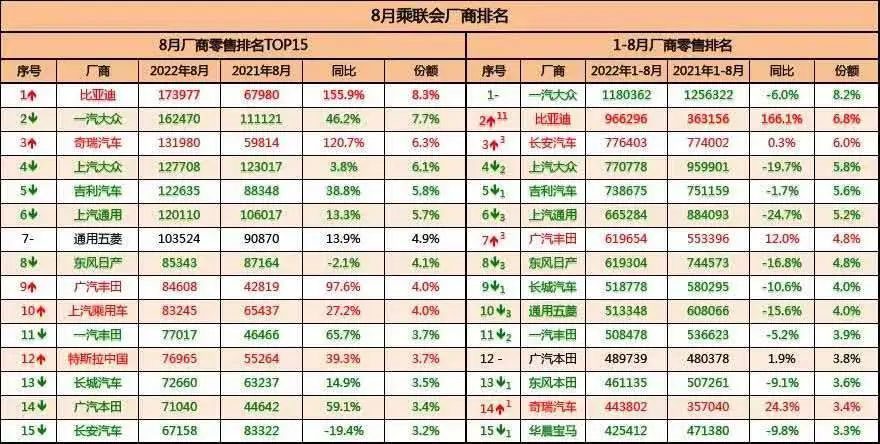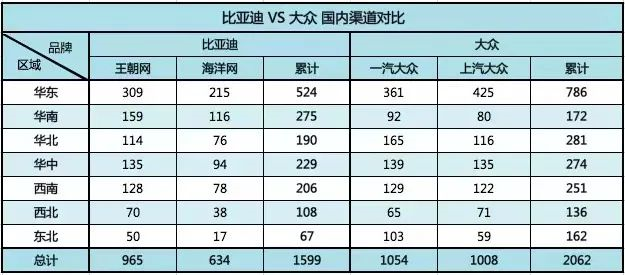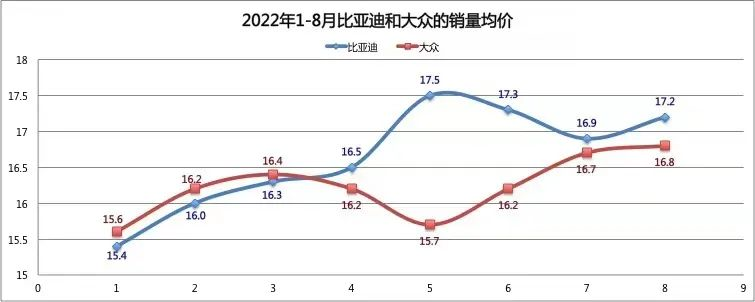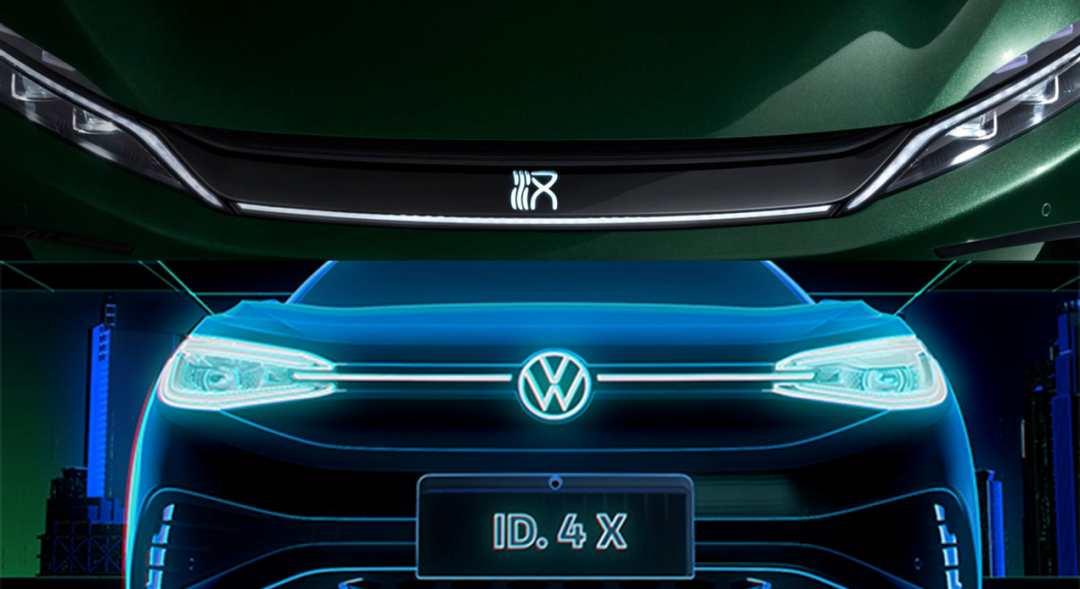Bytedance’s Monthly Sales Volume has Reached New Highs
Special Author | Painless and Comfortable
Editor | Zhu Shiyun
Since June, the monthly sales volume of BYD has been like a runaway horse, repeatedly hitting new highs. From ranking beyond the top 10 in 2021, it has directly entered the top 3. According to the China Passenger Car Association (CPCA), BYD surpassed FAW-Volkswagen again in August to become the “Double Champion” of monthly wholesale and retail sales volume!

From the cumulative data from January to August, the sales volume of BYD reached 966,296 units, a year-on-year increase of 166%, and its ranking increased by 11 places from last year to second place on the manufacturer’s retail sales list, lagging behind FAW-Volkswagen by 220,000 units. At the same time, the cumulative sales volume of the entire market from January to August was 12.95 million units, with only a 0.1% year-on-year increase.
On one hand, although the overall market volume did not change fundamentally, BYD has still created new highs in both market share and same-store sales?
So the question is: If the total volume remains unchanged, then if some people increase sharply on a year-on-year basis, others must have decreased sharply on a year-on-year basis!
So, which customers did BYD win over in the end?
Which Markets has BYD Seized from its Competitors?
1. The Mainstream B-Class Sedan Market
In August, the BYD Han took first place in sales volume in the mainstream B-class sedan market, surpassing the former king, the Accord, and Camry, with a score of 25,987. Of course, the top 20 mainstream B-class sedans not only include domestic brands but also include entry products for BBA.

On the B-Class sedan sales volume list in August, models that experienced a significant decline in rankings include the Teana, BMW Series 3, Toyota Asia Dragon, Cadillac CT5, Ford Mondeo, XPeng P7, Buick Jun Yue, and Tesla Model 3. In particular, the BMW Series 3, XPeng P7, and Teana all dropped more than 4 places in the ranking.
Looking at the cumulative sales of B-Class sedans from January to August, we can see the issue more clearly. The Camry ranked first with 173,418 units, with a year-on-year increase of 40%. The BYD Han ranked second with 149,060 units, with a year-on-year increase of 114%. The Accord ranked third with 141,464 units, with a year-on-year increase of 24%.
However, the sales of traditional B-Class heavyweights Passat, Teana, and Magotan have maintained a year-on-year increase, but their growth rate has fallen behind the average growth rate of the overall market.In the entry-level market, Audi A4L and Mercedes-Benz C-Class continued to grow slightly, while BMW 3 Series’ sales fell 20% year-on-year due to mid-cycle facelifts.
Represented by American B-class cars, both Buick Regal and LaCrosse performed poorly and also saw a decline of over 20% year-on-year.
If we look at the insurance data, it becomes more obvious who the BYD Han is taking market share from: the Passat’s insurance volume from January to August was 96,885, down 22% year-on-year, while the Model 3’s volume was 68,968, down 26% year-on-year. The combined sales of these two cars decreased by 51,000 units year-on-year, while sales of the BYD Han increased by 69,000 units.
In the B-class car market, the BYD Han has become the fastest-growing winner, while the Teana has become an obvious loser, not only falling into the 160,000 RMB price range but also experiencing a year-on-year sales decline, and is likely to be the first to fall behind in the mainstream B-class car market.
2. Mainstream A-Class Car Market
For the A-class sedan market, the regular TOP3 contestants are Xuan Yi, Lang Yi, and Corolla, but this year’s sales ranking pattern has been changed by the BYD Qin. According to data from August, the BYD Qin has surpassed Volkswagen Lang Yi to become the second best-selling A-class sedan, about 15% behind the Xuan Yi’s 43,800 units.
Looking at cumulative data from January to August 2022, only the BYD Qin, Honda Civic, and Buick Velite 7 achieved year-on-year growth, while other A-class sedans, whether old-school or Volkswagen’s dominant models such as Lavida and Sagitar, saw a year-on-year decline of more than 10%. At the same time, Toyota’s Levin and Corolla also saw sales declines of more than 25%.
It is expected that by the end of the year, the BYD Qin will have a chance to challenge the monthly sales champion of the A-class sedan (about 6-7,000 units behind the Xuan Yi’s monthly sales) and the runner-up for the year (only 2,400 units behind the current second place).
For the A-class SUV market, the BYD Song has completely replaced the Haval H6’s SUV market leader position this year. In August, it sold 42,477 units, far ahead of its competitors such as CR-V, H6, RAV4, and CS75Plus.In the cumulative sales data from January to August, BYD Song has become the only car model with sales exceeding 200,000 units. However, the traditional A-class SUVs, such as H6, RAV4, and CS75Plus, have experienced a year-on-year decline of more than 20% in sales.
Only four car models achieved positive growth in the TOP10 list, including BYD Song, BYD Yuan Plus, Toyota Venza, and Volkswagen Tharu.
It can be said that BYD Qin, Song, and Yuan Plus have become popular car models this year in the A-class car market, with a year-on-year sales growth rate exceeding 100%. The main cars that have been displaced are Volkswagen and Toyota’s sedans, as well as Toyota, Great Wall, and Changan’s SUVs.
- The entry-level A0-class sedan market
This level used to be Honda and Toyota’s market as Fit and Yaris have always been the absolute dominators. However, this year, with the hot sales of BYD Dolphin, it completely broke the “balance” of the A0-class sedan market.
In August, Dolphin’s sales volume was 23,298 units, equivalent to the total sales volume of the 2nd to 5th ranking car models, while the former “king” Fit and Yaris dropped to monthly sales levels of 6,000 to 7,000 units.
From the perspective of cumulative sales, except for BYD Dolphin and Ora Good Cat, other petrol-powered car models have fallen into a comprehensive decline, and the proportion of their year-on-year decline is almost all above 15%.
In the A0-class sedan market, BYD has replaced traditional joint venture brands such as Honda, Toyota, and Volkswagen.
- BYD began to replace mainstream joint venture brands
In terms of overall car model sales structure, the mainstream A-class car market composed of Qin Plus series and Song Plus series has caused the same-level products of joint venture car makers to be diverted.
Dolphin, as well as the more entry-level Seagull, completely hit the weak points of joint venture car makers.
Although the volume of Han and Tang series of the B-class car matrix is still slightly smaller than the price-level cars of Volkswagen and Toyota, they have already started to break through in terms of absolute sales volume of a single car model. In particular, Han has become the monthly sales champion of B-class or higher sedans.Overall, Volkswagen is the car company that has suffered the most in this new energy wave and has been replaced the most by BYD as a joint venture automaker.
Volkswagen VS BYD
From January to August, BYD’s average monthly sales were 120,000 units, which can be said to have entered the sales range of mainstream brands. Today, we will compare BYD and Volkswagen in terms of dealership network, sales structure, and changes in sales prices.
1. Dealership Network
As of June 30th, BYD had a total of 1599 stores and 1031 showroom-type sites across the country. Among them, there are 965 Dynasty web stores, 634 Ocean web stores, and a total of about 1031 other city showroom-type, distributors and other types.
The total number of Volkswagen (North-South Volkswagen) stores is 2062, including 1054 stores for FAW-Volkswagen and 1008 stores for SAIC Volkswagen. Volkswagen’s stores are mainly dealerships and do not have other categories.

From the perspective of the number of stores, BYD’s number of stores is slightly lower than Volkswagen, especially the number of Ocean web stores, which is slightly insufficient compared to FAW-Volkswagen and SAIC Volkswagen.
However, BYD’s channel reform speed is very fast this year, not only accelerating the construction of channels but also constantly learning the new forces to increase city showrooms and rapidly increase the coverage of dealership networks through distributors and other channels.
From the perspective of regional distribution structure, in the two regions with the largest passenger car consumption in East China and South China, the number of BYD and Volkswagen brand stores is basically the same in the East China market, but in BYD’s own stronghold—the South China market, BYD has a great advantage in the number of stores compared to Volkswagen brands.
In terms of city size, the dealership network distribution of BYD and Volkswagen is basically the same in various city levels, but since BYD has entered the 100% new energy stage, its proportion in first-tier and new first-tier cities is slightly higher than Volkswagen.
2. Sales Structure
Looking at the overall sales structure, BYD’s overall sales are concentrated in first- and second-tier cities, with a share of 63.8%, while the share of Volkswagen brands (North-South Volkswagen) in first- and second-tier cities is only 56.4%, which is 7.4 percentage points higher than Volkswagen!
In the first-tier cities where BYD has advantages, the sales ratio of BYD is 12%, which is nearly twice that of Volkswagen!
Since Volkswagen’s number of dealerships and layout are more skewed towards third-, fourth-, and fifth-tier cities, Volkswagen’s share in fourth- and fifth-tier cities is six percentage points higher than BYD.
Has the sales structure distribution of BYD and Volkswagen exceeded the cognitive ability of most people?
3. Sales Price
In 2021, the average selling price of one bike for both BYD and Volkswagen was between 140,000-150,000 RMB, and BYD is also the independent automaker with the highest average selling price among the big brands.
In January 2022, the monthly average transaction price of BYD’s brand was 154,000 RMB, slightly lower than the Volkswagen brand’s 156,000 RMB. By August, the average price of BYD’s bike had reached 172,000 RMB, exceeding the Volkswagen brand for 5 consecutive months.
Judging from this trend, with the delivery of the BYD Sea Lion with a sales price of over 200,000 RMB, it is natural that BYD’s average price level will surpass Volkswagen throughout the year.

Looking at the subdivision market, BYD’s sales volume is comparable to Volkswagen’s in the mainstream market of 100,000-200,000 RMB.
Among them, the Dolphin has become the sales champion in the A0-class market of 100,000-120,000 RMB; Song Plus and Qin Plus are in the TOP3 of A-class car sales, among which Song Plus has become the sales champion in the SUV category, while only the Nissan Sylphy and Volkswagen Lavida are ahead of the Qin Plus.
In the market of over 200,000 RMB, BYD’s sales volume is slightly lower than Volkswagen’s, but the root cause of this difference is mainly due to the number of models.
If only looking at a single model, the Han has become the sales champion of all B-level and above sedans, and the Tang is also a hot-selling product in the subdivision market.
When BYD surpassed the leading joint venture brands in sales volume by relying solely on new energy, and also surpassed joint venture brands in the average transaction price of a single bike by relying on the hot sales of new energy passenger cars, is BYD still not a mainstream brand? Who did it replace? We should have a clear understanding.
In this new energy era, BYD firmly grasps two core opportunities: the first is to comply with the trend of the new energy era and switch its product system to 100% new energy; the second is to begin to change the pricing rules and logic led by joint venture brands in the past fuel car era. The second point is more important, because mastering pricing power is the most difficult thing in the Chinese passenger car market!
In the future, once the trend and rules change, replacing joint venture brands will no longer be just a matter of BYD as an independent brand.
This article is a translation by ChatGPT of a Chinese report from 42HOW. If you have any questions about it, please email bd@42how.com.
